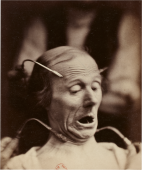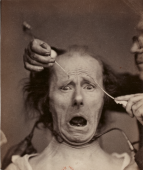Identifying the muscle of fear and terror
Guillaume-Benjamin Duchenne (de Boulogne), 1862
The Mechanism of Human Physiognomy, or the Electro-Physiological Analysis of the Expression of Passions pub'd. by Vve. J. Renouard (Paris), figure 63
With an atlas composed of 74 electro-physiological photographs taken for the most part between 1852 and 1856 by Dr. Duchenne de Boulogne, with the assistance of Adrien Tournachon, a.k.a. "Nadar Jne" ("Nadar the Younger"). Albumen paper prints
BnF, rare book STORAGE, 4-TB52-20
© Bibliothèque nationale de France
“We have seen that figures 56 and 57 express surprise, astonishment and amazement with tremendous realism, through a combined contraction of the depressor of the lower jaw and the occipitofrontalis muscle; but this muscular combination, which produces movements, lines and furrows that seem, at first glance, to be analogous to those painted by fear and terror, does not, however, reproduce those expressions. All that is required for it to appear is to pair the platysma with one of the motor muscles of the eyebrows.” (p. 105)
“In the presence of figures 61, 62 and 63, one can have no doubt: this man is scared near to death, in a frightened stupor; his features express fear and horror from the sight or the news of a terrible, life-threatening danger or an inescapable ordeal. ‒ Before the use of chloroform, the earliest surgical operations commonly brought out comparable expressions of fear and horror. […] This expression of fear can only be rendered perfectly by pairing the platysma and the occipitofrontalis with the depressors of the lower jaw. […] The enlargement of the palpebral opening and the haggard look that can be observed on these faces undoubtedly adds to the effect of their expressions.” (p. 107)
“In the presence of figures 61, 62 and 63, one can have no doubt: this man is scared near to death, in a frightened stupor; his features express fear and horror from the sight or the news of a terrible, life-threatening danger or an inescapable ordeal. ‒ Before the use of chloroform, the earliest surgical operations commonly brought out comparable expressions of fear and horror. […] This expression of fear can only be rendered perfectly by pairing the platysma and the occipitofrontalis with the depressors of the lower jaw. […] The enlargement of the palpebral opening and the haggard look that can be observed on these faces undoubtedly adds to the effect of their expressions.” (p. 107)
Images liées
© BnF, Éditions multimédias, 2018

